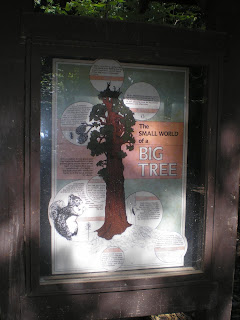Markleeville Library*, CA


Ray Sutliff, former adviser to Santa Cruz Explorer Post 71, atop his usual podium where he works as a docent. He calls it "The Big Stump."
This tree is also know as the Discovery Tree. While others may have seen it previously, backwoods hunter Augustus T. Dowd finally got enough residents of nearby Murphy's gold mining camp to take a look in 1852.

Unfortunately, in 1853 speculators stripped the bark off of the bottome of the tree to make a traveling exhibit which they hoped would produce some income; later that year the Discovery Tree was felled.
Ray reminded me that sequoias are brittle and cannot be cut into lumber as the coast redwoods are. As a guess, this downed giant was shortened about the time of the Civil War, the 1860s.

The bottom part of a moderate-sized sequoia.

The top of the tree in the photo above; note that sequoias don't start dropping cones until they're 75 years old.

The top of another sequoia. According to Storer & Usinger in their magnum opus Sierra Nevada Natural History, sequoias are found from 4700 to 7500 feet in the yellow-pine (principally ponderosa) belt.

No, Preacher Ray isn't speaking to his flock; rather, he spread his hands out to give us some idea of the large size of the base of this downed giant. Sequoias have no tap root in the center but have smaller roots around the perhiphery of their base. Fortunately, the last strong windstorm only felled pines and cedars.

[Click once to enlarge; press ESC to return here.] A large plaque on "The Small Life of a Big Tree."

Were you expecting a squirrel?

Ray is roughly in the middle of this Big Tree.

The spot where Ray was standing in the above photo was near the shiney aluminum rails.

They came by horseback and horseless carriage!

Mother of the Forest. [Click once to enlarge; pres ESC to return here.] Note the saw-marks left by the bark poachers -- which killed this Sequoia. In fact, a Sequoia's bark is the reason it lives so long.

Display panel on the Mother of the Forest.

Display panel titled "Relics of the Past." A new fact is that there are redwoods in remote parts of China.

Hey, Ray! Where's your horse & buggy? Once some Sequoias near Yosemite had passage-ways for horse-drawn vehicles, Calaveras tried to divert some traffic to their grove by whacking a hole in one of their Big Trees.

As one of my grandmothers used to say, "Monkey see; Monkey do!"

Docent Ray Sutliff and his daughter Kathleen Sutliff Everrett on the backporch of their house in Dorrington, CA.
--
Links:
- Calaveras Big Trees web page on Californa State Parks website
- More photos from the World from the Web Calaveras Big Trees page
Markleeville Library's WiFi is on 24/7
--
F 10 Aug Actual Route: Dorrington - Calaveras Big Trees - Lake Alpine - Ebbetts Pass - Silver Crk USFS CG
Sa 11 Aug Actual Route: Silver Crk USFS CG - Markleeville - Monitor Pass - Colville - 2 mi E of Pickel Mdw Marine Camp bd
Su 12 Aug Actual Route: 2 mi E of Pickel Mdw Marine Camp bd - Sonora Pass - Iceberg Mdw - Arnot Crk Trailhead bd
M 13 Aug Actual Route: Arnot Crk Trailhead bd - Donnell Vista - Mi-Wuk Village Library - Long Barn - 1 mi E of N.F. Tuolumne Riv bd
T 14 Aug Route: 1 mi E of N.F. Tuolumne Riv bd - Mi-Wuk Willage - Sonora - Mi-Wuk Village - 1 mi E of N.F. Tuolumne Riv bd
Finding Campgrounds:
- RV Campgrounds from TrailerLifeDirectory.com
- Family Camping Directories from Woodalls.com
- Free campsites website
- Info on finding BLM Campgrounds

No comments:
Post a Comment